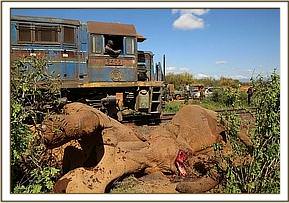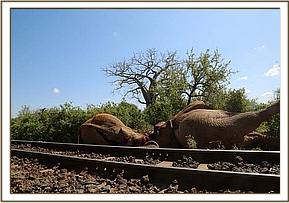Cases of human-wildlife conflict in Tsavo and the surrounding eco-systems are increasing dramatically
Cases of human-wildlife conflict in Tsavo and the surrounding eco-systems are increasing dramatically. As human settlement encroaches on the remaining wild areas and wildlife corridors and as traffic increases on the roads and railway, human and animal casualties are on the rise.
Elephants, especially, have lost massive tracts of land to development. Not only are their habitats decreasing in size, but every year more and more corridors, which allowed elephants to follow the availability of water and food, are being converted for agricultural purposes. Subsistence farm owners who depend on their crops to survive become desperate when elephants, following ancient routes, trample through crops causing irreparable damage. This leads to stand downs with often thousands of community members and leads to casualties on both sides, which unfortunately increases animosity even more. These are the stories you hear on the news, but there is an untold story of the price of human development.
We often hear about cases of elephants trampling people and crops and getting killed in retaliation, but we do not often hear about the many elephants and other animals who tragically lose their lives when they are struck by speeding vehicles and trains. The Mombasa-Nairobi transport corridor divides East and West Tsavo, and wildlife, including Tsavo's elephant populations, frequently have to cross both the busy road and railway as they move from one area to another. Already this year at least 7 elephants have lost their lives in Tsavo alone due to accidents on the road and railway. In March, a lactating female elephant was found dead in the transport corridor. The fact that she was lactating suggests that she left behind a milk dependent orphan. Unfortunately after repeated and extensive searches by DSWT’s aerial and ground units her orphan was never found, so it is likely that two lives were needlessly lost.


Most recently, two young bull elephants were struck by a train near Mtito Andei. They were attempting to cross the railroad in a place adjacent to where soil is being excavated for use on the new high speed rail that is currently under construction. The steep side of the excavation prevented them from being able to get out of the way quickly enough and they were both struck and dragged for more than 50 metres. The bull elephants were hit at about 2:00am and KWS were on site by 5:00am to remove their tusks.


The new railway will be raised off the ground by 4 metres and punctuated by tunnels for wildlife to pass through, so hopefully its construction will reduce the number of fatalities. It is will be very important, however, that elephants and other animals are not able to climb the bank because as this latest incident illustrates, if an elephant finds itself perched between two steep banks with a train hurtling towards it (this time at more than double the speed), the outcome is unlikely to be a favourable one.

